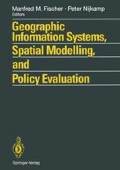Abstract
Of all the roles that GISs perform, their ability to successfully integrate cartographic information from a wide range of sources and scales to create a unified data base is perhaps one of the most important. Ensuring that information held is of a substantive quality however, is very much up to the user.
When data is obtained from several sources, a variety of topographical and categorical differences may be observable between the representations. Processes responsible for such disparities include survey errors, data capture techniques, machine processing to ensure that the data ‘fits’ the current data model being utilised and the temporal infidelity associated with cartographic material.
When each representation is viewed in isolation, such ‘discrepancies’, are often insignificant, however, when the data sets are integrated using polygon overlay techniques, such mismatches become flagged as errors, known as sliver polygons. Generally these correspond to a particular geometrical shape, and so the accepted policy among the majority of the large software vendors is to use this geometrical value as a basis for ‘removal’. Problems arise however when the geometry of the ‘sliver’ polygons correspond to polygons of differences between data sets that are worthy of retention, notably change, such as land use variation.
If the information or attributes of the sliver polygon are taken into account, rather than simply their geometry, the degree of uncertainty associated with their removal will be reduced and the quality of the overlaid material maximised. This contribution looks at the problems of data integration and sliver polygon removal and possible alternatives based on user defined rules.
Access this chapter
Tax calculation will be finalised at checkout
Purchases are for personal use only
Preview
Unable to display preview. Download preview PDF.
References
Beard K (1989) Use error: the neglected error component. Auto–Carto 9, Proceedings of the 9th International Symposium on Computer Assisted Cartography, pp 808–817
Burrough PA (1987) Multiple sources of spatial variation and how to deal with them. In: Chrisman, NR (ed) Proceedings, Auto-Carto 8, pp 145–154
Burnside CD (1979) Mapping from aerial photographs. Wiley and Sons, New York
Chrisman NR (1982) Methods of spatial analysis based on error in categorical maps. Ph. D. thesis, University of Bristol
Chrisman NR (1984) The role of quality information in the long-term functioning of a geographic information system. Cartographica 21: 79–89
Chrisman NR (1987) The accuracy of map overlays: a reassessment. Landscape and Urban Planning 14: 427–439
Chrisman NR (1989 a) Error in categorical maps: testing versus simulation. Auto-Carto 9, Proceedings of the 9th International Symposium on Computer Assisted Cartography, pp 521–529
Chrisman NR (1989b) Modelling error in overlaid categorical maps. In: Goodchild MF, Gopal S (eds) Accuracy of spatial databases. Taylor and Francis, New York
Easterfield ME, Newell RG, Theriault DG (1990) Version management in GIS: applications and techniques. In: Harts J, Ottens HFL, Schölten HJ (eds) EGIS 90, Proceedings of the First European Conference on Geographical Information Systems, EGIS Foundation, Utrecht, pp 288–297
ESRI ( 1987 ) ARC/INFO Overlay manual. ESRI, California
Flowerdew R, Green M (1989) Data integration: statistical methods for transferring data between zonal systems. Paper presented at the 29th European Congress of the Regional Science Association, Cambridge, UK
Langran GE, Chrisman N (1988) A framework for spatiotemporal information. Cartographica 25: 1–14
Openshaw S (1984) The modifiable areal unit problem. Catmog 38
Author information
Authors and Affiliations
Editor information
Editors and Affiliations
Rights and permissions
Copyright information
© 1993 Springer-Verlag Berlin Heidelberg
About this chapter
Cite this chapter
Rybaczuk, K. (1993). Using information based rules for sliver polygon removal in GISs. In: Fischer, M.M., Nijkamp, P. (eds) Geographic Information Systems, Spatial Modelling and Policy Evaluation. Springer, Berlin, Heidelberg. https://doi.org/10.1007/978-3-642-77500-0_6
Download citation
DOI: https://doi.org/10.1007/978-3-642-77500-0_6
Publisher Name: Springer, Berlin, Heidelberg
Print ISBN: 978-3-642-77502-4
Online ISBN: 978-3-642-77500-0
eBook Packages: Springer Book Archive

